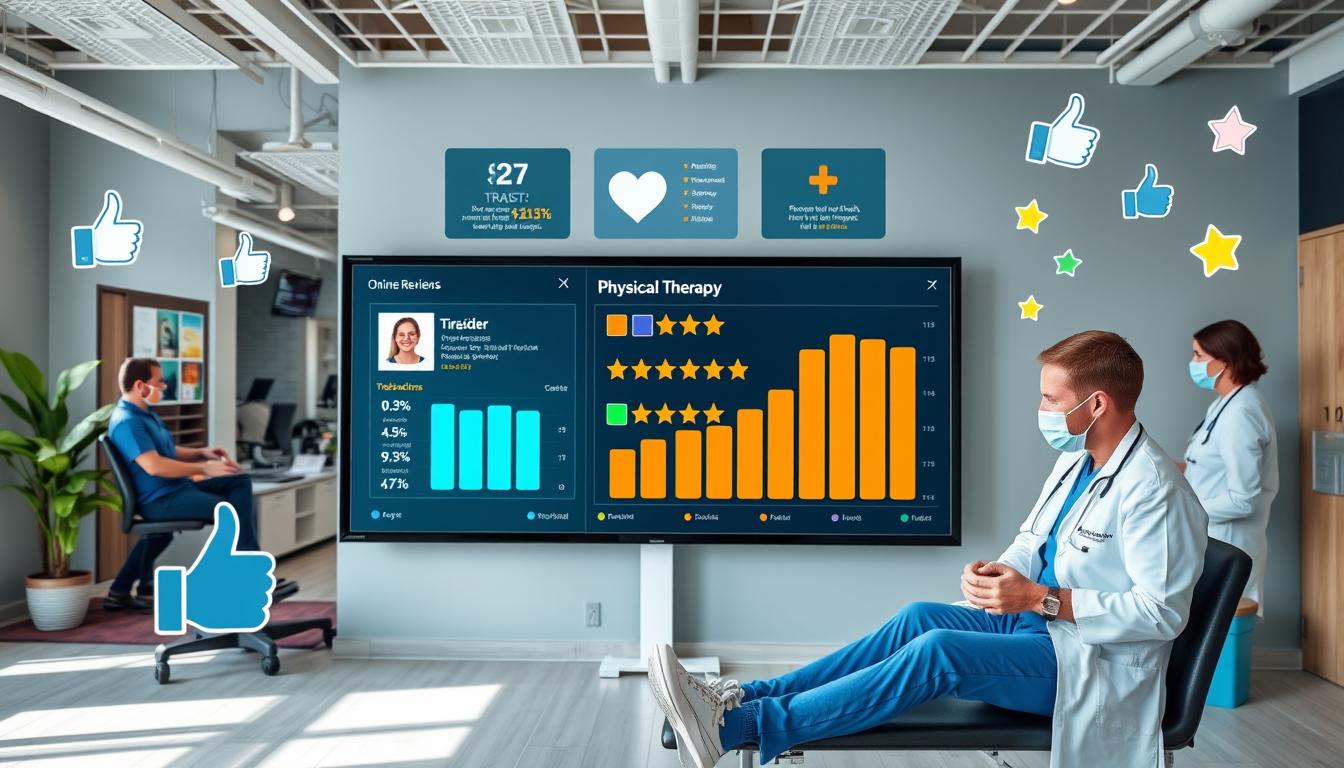Your reputation as a physical therapist is your most valuable asset. Your online presence is often the first thing people see. Studies show that over 77% of patients check online before visiting a doctor.
This means most patients will look at reviews and your website before coming to your clinic. Managing your online reputation is key to attracting new patients and growing your practice.
Key Takeaways
- Over 77% of patients research online before booking an appointment with a physical therapist
- Three-fourths of patients form an opinion about a physical therapy practice based on its online presence
- Effective online reputation management is essential for attracting new patients and growing your physical therapy business
- Positive patient experiences and reviews can have a significant impact on your clinic’s ability to acquire new patients
- Monitoring and responding to both positive and negative reviews is crucial for maintaining a strong online reputation
The Importance of Online Reputation for Physical Therapists
In today’s digital world, having a good online reputation is key for physical therapy success. Studies show that 90% of people check online reviews when looking for healthcare. And 71% start by searching online for a new provider. Even more, 43% might choose a provider outside their insurance network if the reviews are good. Ask for a free consultation.
Online reviews play a big role in our choices. 72% of us look online for health info, and 84% trust online reviews as much as friends’ advice. With more money going to digital ads than TV ads in 2021, a strong online reputation is crucial for physical therapists.
Impact of Online Reviews on Patient Acquisition
Online reviews greatly affect how patients choose their healthcare providers. Lee Resources, Inc. says 91% of unhappy customers won’t return. Also, Conecomm found that 80% of people change their minds after reading bad reviews. But, National Association for Retail Marketing Services notes that 95% of unhappy customers will come back if issues are fixed fast.
How Patients Research Healthcare Providers Online
More and more, people use the internet to find healthcare providers. 68% of all online traffic starts with a search engine. This shows how vital a strong online presence and good reputation are for physical therapists. By managing their online image well, therapists can draw in new patients and keep the ones they have, helping their practice grow. Ask for a free consultation.

“The influence of online reviews and a positive online reputation cannot be overstated for physical therapists. Patients are increasingly using the internet to research and select their healthcare providers, and a strong online presence can be the difference between a thriving practice and one that struggles to attract new patients.”
Understanding Your Current Online Reputation
To manage your physical therapy practice’s online reputation, start by understanding where you stand now. Look at your reviews on sites like Google, Facebook, Yelp, Vitals, Healthgrades, and more. This helps you see how you’re doing online and where you might need to improve.
Identifying Review Sites and Online Directories
Find out where your practice is listed online. Look at big sites like Google, Yelp, and Facebook, and also healthcare-focused ones like Vitals, Healthgrades, and WebMD. Search for your practice’s name and location to get a full view of your online presence. Ask for a free consultation.
Claiming and Updating Your Business Listings
After finding the right sites, claim and update your practice’s listings. Make sure your address, phone number, website, and services are correct and current. Keeping your listings accurate helps your reputation and makes it easier for people to find you.
| Review Site | Claim Listing | Update Information |
|---|---|---|
| ✓ | ✓ | |
| ✓ | ✓ | |
| Yelp | ✓ | ✓ |
| Vitals | ✓ | ✓ |
| Healthgrades | ✓ | ✓ |

“98% of consumers tend to choose places with better reviews for services.”
Monitoring Your Online Reputation
It’s key to keep an eye on your online all the time. This way, you can spot and fix any problems or bad feedback fast. You can use Google Alerts to get updates on mentions of your practice. Also, tools and software can help track reviews and reply to them automatically.
Reviews are everywhere online, on sites like Google, Facebook, Yelp, and HealthGrades. It’s important to answer negative reviews right away. Waiting too long can make the problem worse. If a review gets too heated, it’s best to move the conversation offline.
Getting happy patients to write good reviews can help hide the bad ones. Using tech like WebPT Local can make managing your online image easier. It helps keep an eye on reviews and respond quickly.
| Tool | Description |
|---|---|
| Google Alerts | Set up alerts to monitor mentions of your practice name and related keywords |
| Reputation Management Software | Automate the process of tracking and responding to online reviews |
| WebPT Local | Comprehensive solution for managing online reputation and patient feedback |
By always monitoring your online reputation, you can stay one step ahead. This helps keep your practice’s image strong. It builds trust with patients and brings in new ones.

Responding to Reviews: Best Practices
As a physical therapist, it’s key to reply to every review, whether it’s good or bad. Quick and polite responses to feedback can greatly affect your reputation online. It also helps in getting more patients.
Handling Positive Reviews
When a patient gives a great review, make sure to thank them. Personalize your message and show how much you appreciate their kind words. This shows you value their business and might encourage others to leave positive feedback too. Ask for a free consultation.
Addressing Negative Reviews Professionally
Dealing with negative reviews can be tough, but it’s vital to stay calm and professional. Avoid getting defensive or argumentative, as it can harm your reputation more. Instead, apologize for their bad experience, listen to their concerns, and offer to fix the issue.
By following these best practices, you can manage your clinic’s online image well. Always aim to provide top-notch service and respond to all feedback. This will help you gain new patients and keep the ones you have.

“Positive reviews can significantly boost patient trust and attract new clients, while negative reviews, if handled properly, can provide valuable insights to improve your service.”
Leveraging Positive Patient Experiences
Highlighting positive patient experiences is a great way to improve your online reputation. Look for patients who have seen great results from your care. Ask them to share their stories online. This can help balance out any negative feedback and show the quality of your care.
Identifying Patients with Successful Outcomes
Start by reviewing your current patients. Think about those who have made big progress or are very happy with their treatment. These are the ones you should ask to share their experiences.
- Look for patients who have successfully completed their physical therapy plan and achieved their goals.
- Identify individuals who have provided unsolicited positive feedback, either verbally or through online channels.
- Consider patients who have been with your practice for an extended period and have seen remarkable changes in their health and wellness.
By focusing on these patients, you can use their positive experiences to improve your online reputation. This will attract more patients looking for reliable physical therapy.

“The care I received at [Practice Name] was truly life-changing. I came in with debilitating pain, and the physical therapists worked tirelessly to get me back on my feet. I’m now stronger and more active than I’ve been in years.”
Sharing stories from happy patients can greatly improve your online image. It makes potential clients more confident in choosing your practice for their physical therapy needs. Ask for a free consultation.
Automating Review Requests
As a physical therapist, having a strong online reputation is key. It helps attract new patients and keeps current ones. Automating review requests is a smart way to get more positive feedback. You can send emails asking for feedback and linking to places like Google or Facebook for reviews.
Email Campaigns for Patient Reviews
Tools like ClinicSense help automate email marketing. This lets you keep in touch with patients and ask for feedback and reviews easily.
Managing Positive and Negative Feedback Separately
It’s important to handle positive and negative feedback differently. Give unhappy patients a direct way to share their concerns. This way, your positive reviews stand out, and you can quickly fix any issues.
By automating review requests and managing feedback well, you can improve your online reputation. This helps attract more patients and grow your practice.
“Automation of review requests can lead to more Google reviews, aiding in attracting new patients.”
The Role of Online Reputation in SEO
Your online reputation is key for attracting patients and boosting your SEO. Positive reviews can help your Google because Google favors businesses with good reputations. On the other hand, bad reviews can hurt your SEO, making it harder for people to find you online.
Local SEO helps physical therapy practices show up in local searches. This is crucial since patients often prefer places close to home or work. By getting more positive reviews and optimizing your Google Business Profile, you can improve your reputation and local search visibility.
Doing thorough keyword research and creating content for your area are key for SEO. Make sure your website works well on mobile devices and loads quickly. Also, using online scheduling tools and review systems can improve the user experience and build trust.
Using a mix of SEO and PPC ads can attract quality leads and turn them into loyal patients. Focus on your online reputation and use the latest SEO strategies to rank higher in search engines. This makes it easier for people to find and choose your physical therapy practice.
| SEO Strategy | Benefits |
|---|---|
| Local SEO | Increased search visibility, attracting more local patients |
| Positive Online Reviews | Improved reputation, higher Google rankings |
| Keyword Research | Targeting relevant search terms, improving content relevance |
| Localized Content | Resonating with local audience, establishing authority |
| Mobile Optimization | Enhancing user experience, reducing bounce rates |
By using these SEO strategies, physical therapy practices can improve their search engine rankings. This makes it easier for potential patients to find and choose their services. It can help grow their client base and increase revenue.
Reputation Management Tools and Software
As a physical therapist, keeping a strong online reputation is key. It helps draw in new patients and keeps your current clients happy. Luckily, many tools and software can help with this. They work with your electronic health record (EHR) system, making it easier to manage your online image.
Google My Business is one such tool. It lets you update your business info and get customer reviews. This helps you show up on Google’s first page.
Google Analytics also gives you insights into your marketing and website performance. It shows how popular your pages are. Other tools like Semrush and Surfer SEO help with SEO and content optimization.
| Tool | Key Features |
|---|---|
| Google My Business | Update business info, receive reviews, improve local SEO |
| Google Analytics | Analyze marketing performance, customer behavior, page popularity |
| Semrush | Enhance SEO, conduct keyword research, grow website traffic |
| Surfer SEO | Create content that ranks on the first page of Google |
| Google Search Console | Monitor website indexation, detect issues, improve visibility |
By using these tools with your EHR, you can manage your online reputation better. This lets you focus on giving great care to your patients. Investing in these tools can boost your online image, handle reviews well, and bring in more patients.
“Reputation management is crucial for physical therapists to attract new patients and maintain a positive online image.”
Physical Therapist Marketing
As a physical therapist, having a good marketing plan is key. It helps attract new patients and grow your practice. Online reputation is important, but don’t forget about digital marketing tactics. They help show your skills and gain trust from potential clients. Ask for a free consultation.
Search engine optimization (SEO) is a must. It makes your website easier to find online. This means using keywords, creating content, and improving your site’s tech.
Social media marketing is also crucial. Being active on Facebook, Instagram, and LinkedIn helps you connect with people. You can share useful info and show off your knowledge. This builds your brand and attracts new patients.
Email marketing is great for keeping in touch with patients. Send them useful content, special offers, or reminders. It keeps them coming back and encourages them to tell others about you.
Content marketing is another strong tool. Share educational blog posts, videos, or infographics. It shows you know your stuff and makes you a trusted expert. This attracts new patients and strengthens your relationship with current ones.
Using a mix of these physical therapy marketing strategies and digital marketing tactics helps you reach and engage your audience. This drives growth and success for your practice.
| Marketing Strategy | Potential Benefits |
|---|---|
| Search Engine Optimization (SEO) | Improved visibility in search results, increased website traffic, and higher patient acquisition |
| Social Media Marketing | Enhanced brand awareness, patient engagement, and lead generation |
| Email Marketing | Improved patient retention, increased appointment bookings, and more referrals |
| Content Marketing | Established expertise, increased trust, and better patient education |
Cultivating a Strong Online Presence
In today’s world, having a strong online presence is key for physical therapy practices. It’s not just about managing your online image. It’s also about keeping your brand consistent across all digital platforms. This makes your practice look professional and trustworthy, helping patients feel confident in choosing you.
Maintaining Consistent Branding Across Platforms
Consistent branding is the heart of a strong online presence. Make sure your logo, colors, fonts, and messages match everywhere you’re online. This visual unity creates a lasting, trustworthy impression. It makes it easier for patients to find and connect with your practice.
- Create a clear brand identity that shows what your practice stands for.
- Use the same tone and messages everywhere to build trust with your patients.
- Use high-quality images and graphics to make your online presence look professional.
Building a strong online presence helps attract and keep patients. It also makes your practice a go-to authority in the field. This can lead to more patients and better health outcomes for them.
“90% of searchers haven’t made their mind up about a brand before starting their search.”
| Key Strategies for Building a Strong Online Presence | Benefits |
|---|---|
| Developing a cohesive brand identity | Enhances recognition and trust |
| Maintaining consistent branding across digital channels | Reinforces professionalism and credibility |
| Leveraging high-quality visuals and graphics | Creates a polished, engaging online presence |
By using these strategies, physical therapy practices can create a strong online presence. This presence will resonate with patients, driving growth and success for your business.
Addressing Common Reputation Management Challenges
As a physical therapist, keeping a good online reputation is key to getting and keeping patients. But, it’s not easy. You face challenges like dealing with bad reviews and standing out in a crowded market. Physical therapy practices need to be ready to tackle these issues.
One big challenge is dealing with negative reviews. If patients are unhappy, they might leave bad reviews online. It’s important to answer these reviews well and fix any problems they mention.
Another challenge is keeping a good online image when there’s lots of competition. With more physical therapy practices around, you need to stand out. You can do this by building a strong brand, making sure your online info is up-to-date, and getting involved in your community.
Physical therapy practices might also face PR crises, like bad media coverage or a big incident. Having a good plan for these situations can help protect your reputation. This might mean responding quickly, being open about the issue, and sharing good news to change the story.
To tackle these challenges, physical therapy practices should have a solid reputation management strategy. This could include:
- Keeping an eye on online reviews and answering them well, both good and bad
- Being active on social media and talking to patients and the community
- Encouraging happy patients to leave good reviews and share their stories
- Working on SEO and content marketing to get more online visibility
- Working with a reputation management expert or agency to boost your online image
By facing these challenges head-on and using a smart reputation management plan, physical therapy practices can build a strong online image. This will attract new patients and keep them coming back.
| Challenge | Strategies for Overcoming |
|---|---|
| Negative online reviews | Respond professionally, address concerns, encourage positive reviews |
| Maintaining a positive online presence in a competitive market | Develop a strong brand identity, optimize online listings, engage with the community |
| Handling PR crises | Respond promptly, address issues transparently, share positive content |
Measuring the Success of Your Reputation Management Efforts
To make sure your reputation management works, you need clear metrics and KPIs. These help you see how you’re doing. By checking these often, you can make your strategy better and get the results you want.
Some important metrics to watch include:
- Average review score: Keep an eye on how people feel about your practice based on reviews.
- Number of positive reviews: See how many good reviews you get.
- Review response rate: Check how fast and well you answer reviews, both good and bad.
- Sentiment analysis: Use tools to see if people are mostly happy, unhappy, or neutral about your practice.
Looking at these metrics and KPIs for measuring physical therapy reputation management success gives you useful info. It shows how well your reputation management strategies are working. This helps you know what to improve and keep your online image strong.
| Metric | Description | Significance |
|---|---|---|
| Average Review Score | The overall rating or star-rating of your online reviews | Shows how people generally feel about your physical therapy practice |
| Positive Review Growth | The increase in the number of positive reviews over time | Shows if your reputation management is working to get more good feedback |
| Review Response Rate | The percentage of reviews you respond to, both positive and negative | Shows you care about what patients say and want to improve their experience |
| Sentiment Analysis | The overall tone and sentiment expressed in your online reviews | Gives a deeper look at how patients feel about your practice |
By analyzing the impact of reputation management strategies and watching these key metrics, you can learn a lot. This helps you improve your approach, tackle any problems, and boost your physical therapy practice’s online image.
Staying Ahead of the Competition
In the competitive world of physical therapy, a strong online reputation is key. By keeping an eye on your reputation, answering feedback, and using positive patient stories, you can stand out. This makes you the top choice in your area.
To stay ahead, focus on how to maintain a competitive edge through online reputation management. Also, follow best practices for physical therapy reputation management. This means:
- Always check your online reviews and ratings on sites like Google, Yelp, and Facebook.
- Quickly respond to all reviews, showing you care about patient happiness.
- Use patient success stories to get more reviews and share them online.
- Offer special services, like balance therapy, to make your practice unique.
- Keep a strong online presence with a good website, social media, and marketing.
| Service | Competitive Advantage | Market Potential |
|---|---|---|
| FYZICAL’s Balance Paradigm and Sensory Mismatch Theory | Groundbreaking and only available at FYZICAL | Over 10 million people seek medical help for dizziness annually |
| Continuing education courses for clinicians | STAR Physical Therapy offers 12 different courses | Helps clinicians stay up-to-date and provide better care |
| McKenzie Method certification | STAR Physical Therapy had the most clinicians certified | Specialized treatment approach that can attract patients |
By using these strategies and your unique services, you can stay ahead. This will draw more patients to your practice.
“Offering unique and under-treated specializations, such as balance and vestibular dysfunctions, can help physical therapy practices differentiate themselves and attract more patients.”
Conclusion
Marketing for physical therapists and managing your online reputation are key. They help attract new patients and keep the ones you have. By focusing on your online image, you can build a strong presence online.
It’s important to watch and respond to reviews. Use positive feedback to your advantage. Also, use different marketing tactics to stay ahead.
Using both old and new marketing methods is smart. Make your website easy to use and engage with patients on social media. This builds trust and loyalty.
Use software to track your progress and find what works best. Always look for ways to improve your marketing. This will help you grow your practice.
Keep an eye on your market to find what makes you different. This helps you create marketing plans that stand out. It’s all about attracting and keeping patients.

